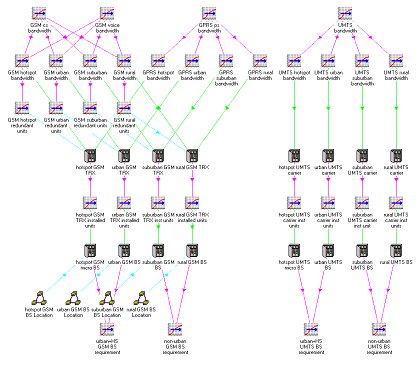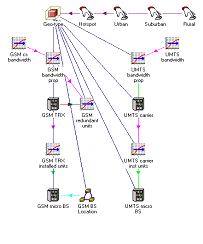New STEM reference models on ADSL, MAN, UMTS and WLAN were
published on this site in February 2002 and have been attracting a lot of attention.
In fact, the model on Service Costing in a Metro Network (MAN) already
showcases the application of template replication to routeing-based node and trunk-level
cost allocation. With the imminent release of STEM 6.2, we are now looking at how
this new technology revolutionises and simplifies conventional approaches to modelling
service packages and cost categories.
Let’s have a quick look at the current UMTS Migration model. This builds
on an existing methodology for modelling GSM networks, in which the significant
distinctions between different customer revenue types are mapped first into common
network circuit or bandwidth requirements, and then disaggregated into different
geographical classifications in order to capture the critical distinctions of deployment
(in terms of configuration and cost).

 The principle of this methodology is fine, but
like many other modelling schemes, the execution can be compromised by the sheer
complexity of the actual model. We maintain multiple service descriptions, all largely
the same, and extended costing structures which must be developed and maintained
in parallel. This is the issue which led to the concept of template replication,
and we are now actively developing an update to the UMTS Migration model which will
see both the service descriptions and costing structures modelled as single Templates,
with concise – and readily extensible – descriptions of the revenue and geo-type
Variants.
The principle of this methodology is fine, but
like many other modelling schemes, the execution can be compromised by the sheer
complexity of the actual model. We maintain multiple service descriptions, all largely
the same, and extended costing structures which must be developed and maintained
in parallel. This is the issue which led to the concept of template replication,
and we are now actively developing an update to the UMTS Migration model which will
see both the service descriptions and costing structures modelled as single Templates,
with concise – and readily extensible – descriptions of the revenue and geo-type
Variants.